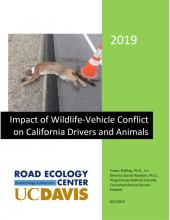Using observations of reported traffic incidents and carcasses the Road Ecology Center has estimated the total annual cost of reported (large) wildlife-vehicle collisions for 2018 in California to be at least $232 million and the cost to society over the last 4 years to be >$1 billion. The cost is calculated using California Highway Patrol (CHP) reports of crashes with wildlife and US Department of Transportation equivalent values for different types of crashes (e.g., property damage vs. major injury). When including accidents that are claimed to insurance companies but un-reported to police, the estimated cost could be as high as $500 million/year (estimated for 2017). This report provides an overview of wildlife-vehicle conflict (WVC) in general, including collisions with small and large animals and accidents resulting from drivers swerving to avoid colliding with an animal. We highlight WVC hotspots on California highways between 2015 and 2018, inclusive, based on a combination of >26,000 traffic incidents involving wildlife that were recorded by the CHP and >42,000 carcass observations reported to the California Roadkill Observation System (CROS, http://wildlifecrossing.net/california) between 2009 and 2018, inclusive. This report includes maps of WVC hotspots, discusses impacts to wildlife and people from WVC, addresses whether mapped “wildlife corridors & linkages” help explain where WVC occurs, and presents new tools to help organizations, state agencies and individuals collect and use this information. Projects to reduce WVC can be the most effective of any safety project, with effectiveness often >90%.
| Attachment | Size |
|---|---|
| Special Report 2019: Impact of Wildlife-Vehicle Conflict on California Drivers and Animals | 3.55 MB |

